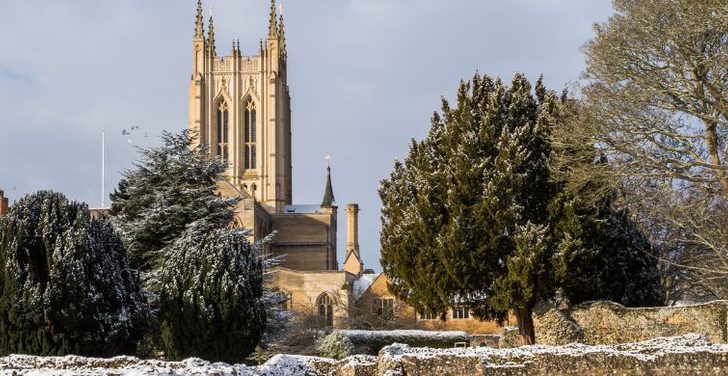
Back to Blogs
Discover
East Anglia and the Wolf
By Robin Herne
The image of the wolf runs deep in Suffolk, particularly in Bury St Edmunds where legend has it that a wolf guarded St Edmund’s head after he was slain. Robin Herne looks at why the wolf is a symbol for East Anglia.
Wolves in East Anglia

Photo: Aden Lewis
Wolves once roamed the woods of East Anglia, and their presence has leant a curious theme to our local history. Even before Roman times, the Iceni tribes of East Anglia were producing coins, called Iceni Staters, bearing the image of stylised wolves, pictured below. Exactly why Boudica’s tribe chose the wolf as a symbol is uncertain - maybe they worshipped a lupine god or goddess, maybe one of their royal dynasties had the wolf as an emblem, or maybe they just admired the beast for its strength and familial devotion. Whatever the case, the creature was clearly dear to their hearts.
When the Romans arrived in Britain they carried the wolf standard with them wherever they went, honouring the she-wolf Lupa who was said to have suckled the abandoned twin boys Romulus and Remus who eventually founded the Eternal City.
Every February 15th the Romans celebrated the Lupercalia, festival of the wolves, and doubtless those imperial citizens settled in our region marked this day too.
Wuffinga Dynasty

Most famously in this area, St Edmund is associated with the wolf. Sometime during the 570s the Anglo-Saxon King Wuffa (whose name means “Little Wolf”) acceded to the throne of the Eastern Angles. He became the sire of the entire Wuffinga dynasty, whose most illustrious member was King Raedwald. Amongst the treasures found in Raedwald’s ship burial at Sutton Hoo is the ornate gold and garnet clasp for a money bag. This clasp depicts a male figure (probably the god Woden) flanked by two wolves.
The last descendant of the Wuffinga line was King Edmund, who met his untimely end at an uncertain location (then called Haegelisdun) in Suffolk. Caught up in battle with the Great Heathen Army, he was tied to a tree and raddled with arrows – allegedly to force him to recant his Christian faith. When he refused to do so the leader of the Danes, Ivar the Boneless, ordered the lopping off of the king’s head. When Edmund’s followers discovered the decapitated body they searched in vain, till a wolf cried out in Latin, “here, here, here!” The linguistically gifted lupine was standing guard over the martyr’s head, and so features on various carvings, flags and suchlike all around Bury to this day.
Wolves at The Abbey

The wolf with St Edmund's head - Bury St Edmunds Guildhall
Bury also has another curious connection to our furry friends. The western tower of the abbey stood where an estate agents’ premises now resides.
When the area was being excavated, quite some years ago, archaeologists found a large pit containing many wolf skulls. The exact reason for this deposit, without benefit of a Tardis to check, can now only be a matter of conjecture.
Some historians hypothesise that this is evidence of some sort of sacrificial offering placed beneath the tower (if this seems odd in a Christian site, bear in mind that early Christianity often melded with pagan practices – for example, an entire bull was buried underneath the altar at Notre Dame cathedral in Paris).
Other historians, of a slightly less romantic turn of mind, conjecture that there might have been a furrier working near the tower who simply discarded unwanted bones in a pit. Many people wore wolf fur for warmth in centuries long past. If it was something as prosaic as a rubbish pit, then it still makes for a very curious coincidence that so many wolf skulls should be found near a sacred site with strong wolf imagery.
Saint Botolph

Wolf mural at The Angel Hotel
In another saintly vein, St Botolph – founder of the now derelict abbey at Colchester and patronym of the town train station – once established various churches, abbeys etc. around the region. A number of the items dedicated to him in centuries past, such as the stone cross from at the Suffolk village of Iken, bear the heads of what are either wolves or dogs.
The story goes that the hermit retired to the marshes of Suffolk to contemplate God. When assorted marsh demons attempted to distract him and prevent the building of churches, he found aid from either a large wolf or possibly dog. This became his especial companion. Botolph is one of the few saints to sometimes be depicted in early iconography as having the head of a wolf or dog (the topic of one of the short stories in my murder mystery anthology, ‘A Dangerous Place’ published by Moon Books). His feast day is June 17th, and Botolph is regarded as a patron saint of both travellers and farmers.
Christianity has a somewhat mixed relationship with the natural world and its flora and fauna. The ancient pagan religions made extensive use of natural imagery, which may explain why the early Church seemed somewhat ambiguous about embracing imagery that was so associated with the religions it was trying to displace. Shepherding was a way of life for many of the peoples amongst whom Christianity first emerged, and the iconography of Jesus as the Good Shepherd stands proud within ecclesiastical tradition. Shepherds seldom have a high opinion of creatures such as wolves, which are prone to devour the occasional lamb. It comes as no great surprise that the early Church often used the image of the wolf as a symbol of the Devil predating upon the flock of Jesus. Sadly this attitude in no small part contributed to the irrational fear of a creature that has never been any real risk to humanity, but has nonetheless been driven close to extinction by our superstitious paranoia.
This article first appeared in the East Anglian Daily Times and is published here with permission from the newspaper and its author Robin Herne, lecturer in Religious Studies at UCS Bury St Edmunds.
Related Blogs

News
Bury Tour Guides to launch…
Bury St Edmunds Tour Guides to Introduce new tours in…

News
Town’s Museum Forms New…
Moyse’s Hall Museum will be forging links with a…

News
St Edmundsbury Cathedral…
St Edmundsbury Cathedral in Bury St Edmunds is…

News
Bury St Edmunds & Beyond…
Step inside many of Bury St Edmunds historic buildings…

News
Bury's Best Pubs with a Past
some notable, historic and somewhat quirky pubs and…
Latest news

News
Bury Tour Guides to launch new tours next year after successful 2025
Bury St Edmunds Tour Guides to Introduce new tours in 2026 and continue the successful Food and Drink Tours!

News
New in Bury St Edmunds For 2026
A sneak peak into new attractions visitors can enjoy in Bury St Edmunds in 2026.

News
Baby It's Cold Outside... Things To Do When the Weather Turns Frosty
Just because the temperature’s dropped doesn’t mean the fun has to! If you’re visiting town during the chillier months, there’s still plenty to see, do, and experience.

News
Christmas Park and Walk 2025

News
Festive Theatre Guide 2025

News
Festive Markets in Bury St Edmunds
Festive markets are set to bring seasonal cheer to Bury St Edmunds this November and December, offering the perfect chance to pick up all of your Christmas essentials!

News
Savour The Winter Season in Bury St Edmunds
Ways to mark the winter season in Bury St Edmunds

News
Where to see fireworks in and around Bury St Edmunds
If you're visiting Bury St Edmunds around bonfire night here’s our roundup of some of the best celebrations in Bury St Edmunds and the surrounding towns and villages.

News
Town’s Museum Forms New Partnership with US Museum
Moyse’s Hall Museum will be forging links with a museum in Salem Massachusetts as part of a project to explore the shared history of the infamous witch trials.
